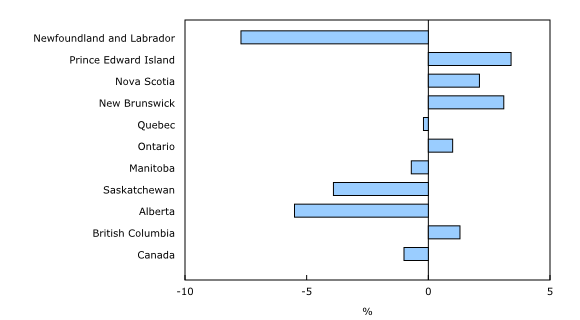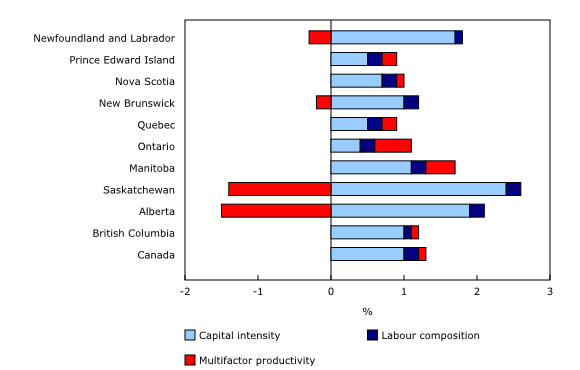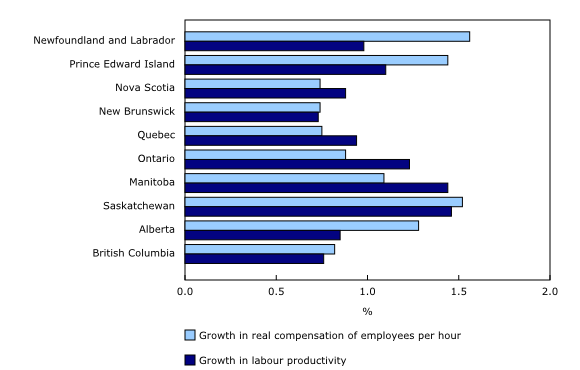Estimates of multifactor productivity growth in the provinces, 2015
Archived Content
Information identified as archived is provided for reference, research or recordkeeping purposes. It is not subject to the Government of Canada Web Standards and has not been altered or updated since it was archived. Please "contact us" to request a format other than those available.
Released: 2017-04-18
Multifactor productivity in the business sector, measured as real gross domestic product (GDP) per unit of combined labour and capital inputs, declined in Newfoundland and Labrador, Quebec and the Prairie provinces in 2015. It increased in Ontario, British Columbia and the Maritimes.
Multifactor productivity measures the extent to which inputs are efficiently used in the production process. Growth in this area is often associated with technological change, organizational change and economies of scale.
Canada's three oil-producing provinces posted a large decline in multifactor productivity in the business sector in 2015, led by Newfoundland and Labrador (-7.7%) and followed by Alberta (-5.5%) and Saskatchewan (-3.9%).
The large decline in multifactor productivity in these three provinces in 2015 followed a small increase or modest decline in their multifactor productivity over the period 1997 to 2014.
In 2015, the sharp decline in multifactor productivity of the business sector in these three provinces reflected a cyclical decline in their real GDP, due to a sharp decline in commodity prices. In 2015, real GDP in the business sector declined in Alberta (-5.0%), Newfoundland and Labrador (-3.4%) and Saskatchewan (-2.2%). Despite the decline in real GDP, the combined capital and labour input of Alberta, Saskatchewan and Newfoundland and Labrador increased.
As a result of stronger GDP growth, Prince Edward Island and New Brunswick reported the largest growth in multifactor productivity in the business sector in 2015 at more than 3% each.
In contrast, multifactor productivity showed little change in Prince Edward Island over the 1997 to 2014 period, while it declined at an annual rate of 0.4% per year in New Brunswick during that period.
Overall, multifactor productivity declined by 1.0% in the Canadian business sector in 2015.
Multifactor productivity change from 1997 to 2015
Multifactor productivity is one of the three components of labour productivity growth, the other two being increases in capital intensity and skills upgrading of labour.
From 1997 to 2015, multifactor productivity growth was an important source of labour productivity growth in Ontario and Manitoba. It contributed 0.5 percentage points per year to labour productivity growth in Ontario and 0.4 percentage points per year in Manitoba.
Multifactor productivity growth made a small or negative contribution to labour productivity growth in the remaining provinces from 1997 to 2015.
Capital intensity in the business sector increased in every province from 1997 to 2015. The increase in capital intensity was largest in the three oil-producing provinces of Newfoundland and Labrador, Saskatchewan, and Alberta, contributing from 1.7 to 2.4 percentage points per year to the growth in labour productivity in these provinces over this period.
Skills upgrading contributed from 0.1 to 0.2 percentage points to labour productivity growth in all provinces. The contribution of skills upgrading reflected increases in the average education and experience level of workers.
Overall, multifactor productivity contributed 0.1 percentage points per year to labour productivity growth in the Canadian business sector from 1997 to 2015. The increase in capital intensity was the largest contributor to labour productivity growth during that period (1.0 percentage points per year), while skills upgrading contributed 0.2 percentage points per year.

In celebration of the country's 150th birthday, Statistics Canada is presenting snapshots from our rich statistical history.
Estimates for business sector labour productivity by province can be extended back to 1984. Over long periods of time, real wage compensation and productivity growth are generally expected to exhibit a positive relationship, reflecting the fact that productivity growth is the main source of real wage growth in an economy. Chart 3 shows that across provinces, real compensation of employees per hour and labour productivity growth tended to have a positive relationship over the past 30 years. Overall, since 1984, provinces with lower labour productivity growth, such as Nova Scotia and New Brunswick, tended to have lower growth in real compensation of employees per hour worked. In contrast, provinces with relatively higher growth in labour productivity, such as Saskatchewan and Prince Edward Island, tended to have higher growth in compensation of employees per hour worked.
Note to readers
This release covers the experimental database on provincial multifactor productivity and related variables by the business sector industry from 1997 to 2015. Data include multifactor productivity, value-added, capital input and labour input in the aggregate business sector and major sub-sectors.
This experimental database is constructed using a methodology that is similar to the one used to construct multifactor productivity estimates at the national level released in The Daily on March 16, 2017.
Data in this release reflect the estimate of gross domestic product by industry in the provinces from 1997 to 2015, published in The Daily under provincial and territorial economic accounts on November 9, 2016; estimates of fixed assets for 2015, published in The Daily on November 18, 2016; and estimates of hours worked and labour productivity by industry in the provinces from 1997 to 2016, published in The Daily on February 10, 2017.
Multifactor productivity measures at Statistics Canada are derived from a growth accounting framework that allows analysts to isolate the effects of increases in input intensity and skills upgrading on the growth in labour productivity. The residual portion of labour productivity growth that is not attributable to increases in input intensity and skills upgrading is called "growth in multifactor productivity". It measures the efficiency with which the inputs are used in production. Growth in this area is often associated with technological change, organizational change, economies of scale and variation in the utilization of inputs.
Products
A description of the method used to derive productivity measures can be found in the "User Guide for Statistics Canada's Annual Multifactor Productivity Program," as part of The Canadian Productivity Review series (15-206-X).
The documentation about the recent revisions to multifactor productivity growth estimates can be found in "Revisions to the Multifactor Productivity Accounts," as part of The Canadian Productivity Review series (15-206-X).
Contact information
For more information, or to enquire about the concepts, methods or data quality of this release, contact us (toll-free 1-800-263-1136; 514-283-8300; STATCAN.infostats-infostats.STATCAN@canada.ca) or Media Relations (613-951-4636; STATCAN.mediahotline-ligneinfomedias.STATCAN@canada.ca).
- Date modified:




